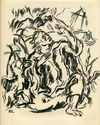
19th, 20th & 21st Century Fine Prints
707-546-7352 · fax 707-546-7924 · web: www.annexgalleries.com · email: artannex@aol.com
Karl Caspar Biography
Karl Caspar
German
1879–1956
Biography
Karl Caspar, painter, printmaker and educator, was born in Friedrichshafen, Germany, on March 13, 1879. He studied at the State Academy of Fine Arts in Stuttgart, where he become a member of the Stuttgart Artists' Association and the German Artists' Association. Following graduation, he enrolled at the Academy of Fine Arts in Munich, where he would establish his studio and career.
In 1913, Caspar was a founding member of the Münchener Neue Secession, which included Alexej von Jawlensky, Paul Klee, Wladimir von Bechtejeff, and Alexander Kanoldt. From 1922 to 1937, Caspar was a professor at the Academy of Fine Arts in Munich. With the rising Nazi power, Caspar’s as well as many of other artists' works were branded “degenerate” and were confiscated by the Nazis for display in their 1937 Degenerate Art Exhibition, meant to destroy the careers of anti-totalitarian artists, writers, and thinkers. Despite his Christian-themed works, Caspar was included in the show based on his Impressionist and Expressionist styles. He was subsequently let go from his position as professor at the Academy and his work held in museums and galleries was destroyed. He soon relocated with his family to Brannenburg, Germany where he remained for the rest of his life.
Once the second World War had concluded, Caspar was invited back to the Academy in Munich where his position was fully reinstated, and in 1948 he become a founding member of the Bavarian Academy of Fine Arts.
In 1950 Germany awarded Caspar the Order of Merit of the Federal Republic. He was also awarded the Upper Swabian Art Prize jointly with his wife, painter Maria Filser, in 1952. He became a member of the Berlin Academy of Arts in 1955.
His work can be found in the collections of the Abteiberg Museum in Mönchengladbach, and the Zeppelin Museum in Friedrichshafen, Germany; the Sztuki Museum, Lodz, Poland; and the Los Angeles County Museum of Art, USA.
Karl Caspar died in Brannenburg, Germany on September 21,1956.

